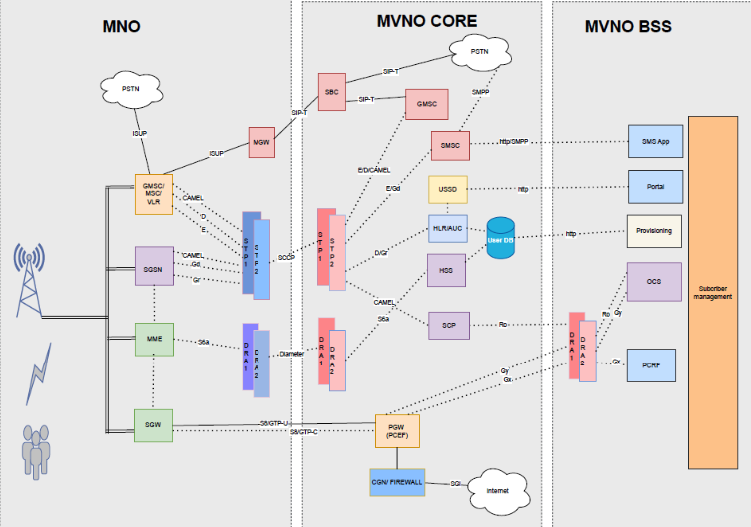
VIVADA MVNO CORE STACK
Vivada is a complete, turnkey solution that enables the delivery of voice and data connectivity, interconnection with MNOs, and connectivity solutions for both urban and remote locations. It provides key core network elements that is required to deliver connectivity, offer services, and manage reseller and subscriber accounts.
VIVADA MVNO CORE STACK
Vivada is a complete, turnkey solution that enables the delivery of voice and data connectivity, interconnection with MNOs, and connectivity solutions for both urban and remote locations. It provides key core network elements that is required to deliver connectivity, offer services, and manage reseller and subscriber accounts.
WTL offers a complete range of MVNO core system with the capability to seamlessly integrate with standard BSS systems to give a complete and robust infrastructure for MVNO business operations.
Our complete core system is also designed to interconnect with mobile operators’ network to enable you to co-ordinate and manage your network and deliver rich services to subscribers.
WTL Core is designed in such a way that it supports your plan from setup to scale out. It delivers outstanding performance and supports a huge diversity of services offered by MVNOs.
WTL’s Core elements are 3GPP compliant and supports 2G/3G, 4G and 5G spectrums.

WTL Vivada Core Elements
HLR
The Home Location Register (HLR) and Authentication Center (AUC) are critical for Mobile Virtual Network Operators (MVNOs). The HLR stores subscriber information, enabling effective management, personalized services, and efficient call routing. The AUC ensures subscriber authentication and secure access to network services.
HSS
The Home Subscriber Server (HSS) is a pivotal component in modern telecommunications networks, especially in LTE. Its importance lies in managing crucial subscriber information, including profiles and authentication credentials, ensuring secure network access.
SMSC
The Short Message Service Center (SMSC) is of paramount importance to Mobile Virtual Network Operators (MVNOs) as it serves as the core component for managing and delivering text messages. It enables MVNOs to provide essential SMS services to their subscribers, facilitating effective communication, message routing, and storage.
USSD
Unstructured Supplementary Service Data (USSD) is highly important for Mobile Virtual Network Operators (MVNOs) due to its real-time interactive capabilities. MVNOs leverage USSD for immediate service provisioning, financial transactions, and personalized service customization.
SCP
The Service Control Point (SCP) is crucial for Mobile Virtual Network Operators (MVNOs) as it empowers them to innovate and personalize value-added services for their subscribers. SCP allows MVNOs to define customized service logic, implement advanced call routing, and integrate with third-party services.
STP
The Signaling Transfer Point (STP) is crucial for Mobile Virtual Network Operators (MVNOs) as it plays a central role in signaling routing within the SS7 network. It facilitates efficient communication between different network elements, manages signaling traffic between MVNOs and external networks, and supports global title translation for seamless interoperability.
GGSN
The Gateway GPRS Support Node (GGSN) is crucial for Mobile Virtual Network Operators (MVNOs) as it serves as the gateway for data services in the 2G/3G network. GGSN facilitates efficient packet routing, manages IP address allocation, controls bearers and Quality of Service (QoS), supports roaming, integrates with billing systems, and ensures the security of data transmissions.
PGW
The Packet Data Network Gateway (PGW) is crucial for Mobile Virtual Network Operators (MVNOs) as it manages data connectivity, controls IP address allocation, oversees bearer management and Quality of Service (QoS), supports roaming, integrates with billing systems, enforces policies, and ensures the security of data transmissions in the 4G network.
PCEF
The Policy and Charging Enforcement Function (PCEF) is vital for Mobile Virtual Network Operators (MVNOs) as it plays a central role in shaping and delivering data services, ensuring that MVNOs can provide transparent, fair, and personalized data offerings to their subscribers while efficiently managing network resources.
GMSC
The Gateway Mobile Switching Center (GMSC) is crucial for Mobile Virtual Network Operators (MVNOs) as it facilitates the connection between the MVNO and the core infrastructure of the host Mobile Network Operator (MNO). GMSC is essential for call routing, connectivity, and interconnection with MNOs.
SBC
This is the Session Border Controller that provides security and manages communication sessions between the different networks.
IMS (VoLTE)
IMS (IP Multimedia Subsystem) is used to provide multimedia services such as voice over LTE (VoLTE) and video calling.
EPC (MME, SPGW, PCRF, EMS)
This is the Evolved Packet Core that provides the core network for LTE (Long-Term Evolution) or 4G mobile networks.
- The MME (Mobility Management Entity) handles signaling and authentication while the SGW (Serving Gateway) and PGW (Packet Data Network Gateway) handle data traffic.
- PCRF (Policy and Charging Rules Function) manages quality of service and charging policies.
- EMS (Element Management System) is used for network management and monitoring.
What Our Clients Say




